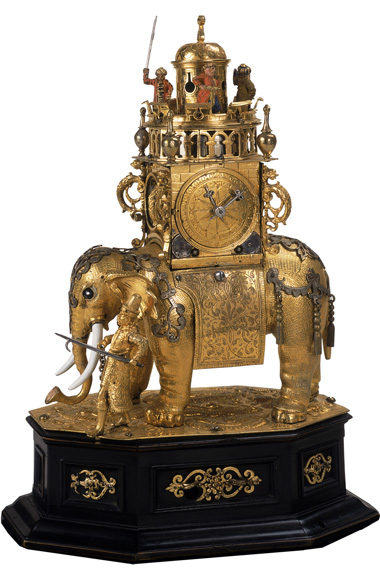Elephant Automaton Clock
Elephant Automaton Clock, 1600–1625
German (Augsburg)
Gilt metal with enameling
Presented to the Martin D'Arcy Museum of Art by Mrs. Thomas Stamm with deep appreciation and affection in recognition of Rev. John J. Piderit, S.J., 22nd President, Loyola University Chicago, 1989-03
Automata are mechanical devices fashioned to resemble living things, most often humans or animals. The creation of automata dates back to antiquity, when their mechanisms were driven by water. Few examples, however, survive from before the sixteenth century. In addition to being valued for their aesthetic qualities, automata represented wondrous examples of scientific achievement.
Among the most widespread forms of automata were clocks, such as the D'Arcy's elephant automaton. Elephants were a popular decorative motif in the seventeenth and eighteenth centuries, and may have been inspired by Eastern examples. The elephant, as a trampler of snakes, signified Christ trampling the Devil. Considering the Turkish figures which stand atop the clock tower, the allusion to the elephant could also refer to the Christian victory over the Turkish invasion of the Holy Roman Empire.
At the end of the Renaissance, clocks with automata such as the D'Arcy elephant were fashionable as amusing table decorations for great banquets that provided diversion to guests. When this particular clock strikes the hour, the elephant's eyes rotate and the Turkish figures on top move around in a circle. In addition, the elephant handler's arm moves up and down, propelling the elephant across the table. It is not difficult to imagine the spectacle that this automated elephant would have created at a banquet!
This elephant clock was created in Augsburg, a center of European metalwork and automata production in the seventeenth century. Augsburg clocks are distinguished by their high-quality chased metal work and engraving, by their architectural design, and by the complication and precision of their mechanism. Glass portholes on either side of the elephant's clock tower allow one to see the internal gears and mechanical devices which bring this automaton to life. The D'Arcy elephant clock is also representative of the Augsburg style of automata, as it features a hexagonal ebony base decorated with wrought iron work.
The popularity of automata influenced the spread of Christianity in the East. From the time China first had contact with the West, clocks were in high demand─particularly those featuring automata. Father Matteo Ricci and other Jesuits were permitted to settle in Peking in 1601 largely on account of the curious clocks and watches they brought with them. Later, when there was discussion of sending the missionaries home, the Jesuits were allowed to stay for an extended period in return for helping to keep the clocks running.
Elephant Automaton Clock, 1600–1625
German (Augsburg)
Gilt metal with enameling
Presented to the Martin D'Arcy Museum of Art by Mrs. Thomas Stamm with deep appreciation and affection in recognition of Rev. John J. Piderit, S.J., 22nd President, Loyola University Chicago, 1989-03
Automata are mechanical devices fashioned to resemble living things, most often humans or animals. The creation of automata dates back to antiquity, when their mechanisms were driven by water. Few examples, however, survive from before the sixteenth century. In addition to being valued for their aesthetic qualities, automata represented wondrous examples of scientific achievement.
Among the most widespread forms of automata were clocks, such as the D'Arcy's elephant automaton. Elephants were a popular decorative motif in the seventeenth and eighteenth centuries, and may have been inspired by Eastern examples. The elephant, as a trampler of snakes, signified Christ trampling the Devil. Considering the Turkish figures which stand atop the clock tower, the allusion to the elephant could also refer to the Christian victory over the Turkish invasion of the Holy Roman Empire.
At the end of the Renaissance, clocks with automata such as the D'Arcy elephant were fashionable as amusing table decorations for great banquets that provided diversion to guests. When this particular clock strikes the hour, the elephant's eyes rotate and the Turkish figures on top move around in a circle. In addition, the elephant handler's arm moves up and down, propelling the elephant across the table. It is not difficult to imagine the spectacle that this automated elephant would have created at a banquet!
This elephant clock was created in Augsburg, a center of European metalwork and automata production in the seventeenth century. Augsburg clocks are distinguished by their high-quality chased metal work and engraving, by their architectural design, and by the complication and precision of their mechanism. Glass portholes on either side of the elephant's clock tower allow one to see the internal gears and mechanical devices which bring this automaton to life. The D'Arcy elephant clock is also representative of the Augsburg style of automata, as it features a hexagonal ebony base decorated with wrought iron work.
The popularity of automata influenced the spread of Christianity in the East. From the time China first had contact with the West, clocks were in high demand─particularly those featuring automata. Father Matteo Ricci and other Jesuits were permitted to settle in Peking in 1601 largely on account of the curious clocks and watches they brought with them. Later, when there was discussion of sending the missionaries home, the Jesuits were allowed to stay for an extended period in return for helping to keep the clocks running.

